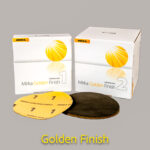A closer look at Mirka Microstar
Mirka Microstar is a film backed abrasive – meaning super thin – super flat – yet flexible. Mirka Mirka Microstar is available if very fine grits in small increments up to 2500.
Mirka Microstar shines for fine post finish work, such as de-nibbing, spot repairs on finish imperfections, or for a final super-flattening before polishing. A few passes with Mircostar is even a good way to check for fair and level flatness.
Lapping films have been around for a while in the industrial market, but they are a relatively recent addition to coated abrasives for small machine sanding operations such as Woodshops and Bodyshops. Film can be made very strong, very durable and extremely tear resistant, while still being a flexible backing medium and while being a micro thin. Unlike a knitted backing like Abralon which preserves the surface profile, when the flexible film stretches around a surface imperfection, the surface pressure on the high spot of the imperfection increases making it abrade faster at that spot then it does on the rest of the surface. This increased pressure continues until that spot is back flat and even with the rest of the surface.
Although film withstands being wet, we recommend it for dry use. Because it is a product that does its best in the world of post-finishing, it is typically used without any holes dust and chip ejection holes. Although this does not provide for very good dust extraction, that is rarely a problem because by that point in the finishing process the dust becomes more of a powdery film that gathers on the surface of your work, and then is most easily, and very effectively removed with a microfiber cloth between passes. The amount of “dust” produced is so slight and insignificant, that most of it stays on the surface until removed and contained by the microfiber cloth. Often by the time you are at that stage of finishing, one pass with Microstar is about all that is needed anyway. Using only one pass and then cleaning with a micro-fiber cloth assures that you know where on the surface you have been which helps to prevent burn-through caused by abrading some areas more than others. This is a product ideal for flattening and perfecting a surface, not so much for removing stock or material.
Where dust is still a problem, best to just switch back to Abranet. At our shop we use Abranet up to 1000 grit before switching to Microstar, and then usually one pass at 1200 or 1500 does the trick and its time for wet sanding with Abralon. After wetsanding, it is polishing with Polarshine. For flattening orange-peel, or for dust nibs in hard finishes like epoxy or urethane and polleys, its pretty much the same process. We typically start right at 1500, one pass, very light, wipe with a microfiber cloth, and then once the surface profile is consistant and right where we want it, its usually right to wet sanding with Abralon and then to polishing with Polarshine 10. Sometimes, but rarely, a second pass with 2000, but again, we are not intending to remove material at this point. An interface pad helps on curved and irregular surfaces. Most of all, Be careful, go light, especially on the second pass.
Mirka Microstar is meant to be used on fully cured finishes, as there is not much to protect from pilling from partially cured finishing. On hard surfaces, the special stearate layer gives excellent protection against pilling. So until you are comfortable with your substrate being fully cured, look often at your paper in the beginning and be sure its not clogging or pilling. Sanding debris should be no more than an slight and even dusty film that wipes up quickly with a microfiber cloth. Use very low pressure and don’t linger in any one area. This is precision sanding. Pilling at this point of the finishing process will damage your work. It would be horrible.
Mirka Microstar works best with machine sanders that have a soft-start feature, such as the Mirka DEROS and DEOS. Any sudden Starts and Stops at this stage of the finishing process can leave surface damage that is hard to contend with. And by all means, start with the sander already flat on your workpiece. In our shop, and with the finishes we use, we have found 8000 rpm to be an ideal upper speed for Microstar. For your work, whenever working with new materials, surfaces or coating it is always good to experiment on a test piece or something that doesn’t matter.
The consistent fine scratch pattern also makes Microstar an ideal product for breaking the refraction on a finish for a more matt or satin look. Follow with only a very light wet-sand and polish.
If you like what Mirka Microstar does for your post finish work, consider also trying Mirka’s Golden Finish for a similar effect.
In our shop we also use Mirka Microstar when we want a super shine on solid surface. In that case, we run through all of the grits from 1200 to 2500 and then we switch to Abralon 3000 and 4000 wet, and then micro polish with Polarshine 10.


 Golden Finish
Golden Finish Iridium
Iridium